St Damian Cross
The crucifix of St. Damien is an icon of the glorious Christ. It is the fruit of a quiet meditation, a careful contemplation, accompanied by a time of fasting. At the first glance, we immediately discover the central figure: Christ. He is the most dimensionally important character. Cover much of the Cross. In addition, and above all, it stands out on the background: Christ, and only Him, is full of light. His whole body is bright. Highlight over the other characters, it's as before. Behind his arms and feet, the black color symbolizes the empty tomb: darkness is a sign of darkness.
The light that floods the body of Christ, springs from within his person. His body radiates clarity and comes to enlighten us. The words of Jesus come to our mind: «I am the light of the world; he who follows me will not walk in darkness, but will have the light of life ”(Jn 8,12). How right Francis was when he prayed: "High, glorious God, illuminate the darkness of my heart."
We are before a Christ inspired by the Gospel of Saint John. It is the Christ Light, and also the Glorious Christ. Without tensions or pain, he is standing on the Cross. It doesn't hang on her. His head is not touched with a crown of thorns; He wears a crown of glory.
We are on the other side of historical reality, the crown of thorns that existed for a few hours and the sufferings that earned him the crown of Glory. Looking at him, we think perhaps of his death, of his pains, of which several traces appear: the blood, the nails, the sore on the side; and yet we are beyond death. We contemplate the glorious, living Christ.
Christ also denotes donation, abandonment trusting in the Father. He says in the Gospel of Saint John: «... I give my life ... No one takes it from me; I give it voluntarily ... No one has greater love than he who gives his life for his friends ”(Jn 10,17-18; 15,13). Here is the Christ who gives himself, who gives himself. He seems to offer himself, willing to everything, trusting in the Father.
It is also a Christ who welcomes the world. He has his arms extended, as if wanting to embrace the universe.
His hands remain open, as if to shelter us and nest in them. They are also open up, inviting us to look beyond ourselves, in the direction of heaven. Are they not also open to help us, to sustain our steps and get up after our falls?
The face of Christ is a serene, calm face. In line with the beautiful tradition of icons, it has big eyes, small mouth, almost invisible ears. Why? In the contemplation of the Father, in the world of Glory, the word is no longer needed, nor is it necessary to listen. Just see, look, love. Like Christ contemplating his Father.
He has wide eyes. They look through us to all men. His gaze involves those who are close, those who contemplate him, but he is at the same time attentive to all. "This is my blood shed for you and for the multitude" (cf. Mt 26,28). With his gaze he reaches all generations, the men of today, all who will be. Come to save them all.
In short, we are before the living Christ, full of serenity and glory, abandoned to his Father and turned to men. Here is the Christ contemplated by Francis!



Comments
Post a Comment